Ultimate Beginners Guide To Canadian Road Signs And Traffic Regulations

Understanding Canadian road signs and traffic rules is essential for every new driver. Whether you're preparing for your driving test or just starting out on the road, knowing what each sign means and how to navigate Canadian traffic can help boost your confidence, help ensure your safety as well as the safety of others on the road and avoid fines. In this guide, we’ll break down the basics of Canadian road signs, explain key traffic rules, and offer practical tips to help you master them.
1. Understanding Canadian Road Signs
Road signs in Canada are designed to communicate important information quickly and clearly. They are generally divided into four main categories
![][image2]
Regulatory Signs: These signs provide the rules of the road, such as stop signs, and no-entry indicators and speed limit. They are typically square or rectangular, with clear symbols or text. A sign with a green circle means you may or must do the activity shown inside the ring. A red circle with a line through it means the activity shown is not allowed. Here are some common regulatory signs:
A stop sign means you must come to a complete stop. Stop at the stop line if it is marked on the pavement. If there is no stop line, stop at the crosswalk. If there is no crosswalk, stop at the edge of the sidewalk. If there is no sidewalk, stop at the edge of the intersection. Wait until the way is clear before entering the intersection.
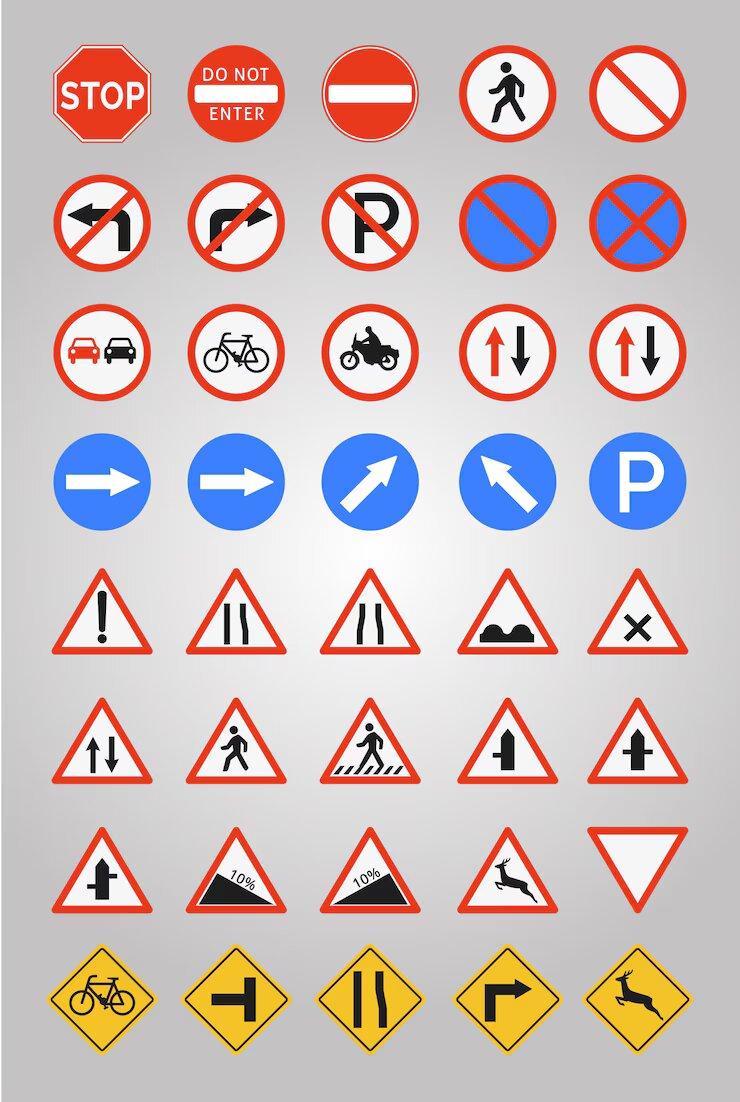
.
Official bicycle route sign. Watch for cyclists and be prepared to share the road with them.

Posted time parking sign (Used in pairs or groups.)

Snowmobiles may use this road.

Do not enter when you see this sign.

Do not stop in the area between the signs. This means you may not stop your vehicle in this area, even for a moment.

Do not stand in the area between the signs. This means you may not stop your vehicle in this area except while loading or unloading passengers.

Do not park in the area between the signs. This means you may not stop your vehicle except to load or unload passengers/merchandise.

Do not turn left at the intersection.

Do not drive through the intersection.

Do not turn to go in the opposite direction. (U-turn)

Do not turn right when facing a red light at the intersection.

Do not turn left during the times shown.

This parking space is only for vehicles displaying a valid Accessible Parking Permit.

Keep to the right of the traffic island.

Speed limit changes ahead.

Do not pass on this road.

Slow traffic on multi-lane roads must keep right.

Indicates areas where a special risk to pedestrians have been identified.. Traffic related offences committed within the zone are subject to increased fines.

The speed limit in this zone is lower during school hours. Observe the speed limit shown when the yellow lights are flashing.
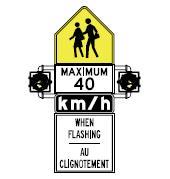
Stop for the school bus when signals are flashing.

These signs, above the road or on the pavement before an intersection, tell drivers which way they must travel. For example: the driver in lane one must turn left; the driver in lane two must turn left or go straight ahead; and the driver in lane three must turn right.

Traffic may travel in one direction only.

This is a pedestrian crossover. Be prepared to stop and yield right-of-way to pedestrians.

This sign, above the road or on the ground, means the lane is only for two-way left turns.

This sign reserves curb area for vehicles displaying a valid Accessible Person Parking Permit picking up and dropping off passengers with disabilities.
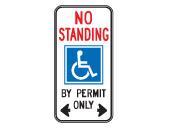
These signs mean lanes are only for specific types of vehicles, either all the time or during certain hours. Different symbols are used for the different types of vehicles. They include: buses, taxis, vehicles with three or more people and bicycles.

Keep to the right lane except when passing on two-lane sections where climbing or passing lanes are provided.

This sign on the back of transit buses serves as a reminder to motorists of the law requiring vehicles approaching a bus stopped at a dedicated Bus Stop to yield to the bus, once the bus has signalled its intent to return to the lane.
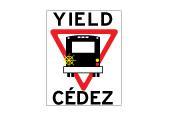
Road forks to the right.

Marks a zone within which school buses load or unload passengers without using the red alternating lights and stop arm.
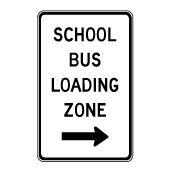
High Occupancy Vehicle (HOV) signs
Only public vehicles such as buses, or passenger vehicles carrying a specified minimum number of passengers, may use this lane.
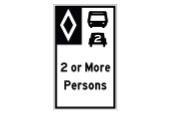
Vehicles cannot change lanes into or out of a high-occupancy vehicle lane in this area.

Warning Signs: These alert drivers to potential hazards ahead, like sharp curves, pedestrian crossings, or wildlife crossings. They are usually diamond-shaped, put on a red/yellow board and feature bold symbols to grab your attention.Here are some common warning signs:
Narrow bridge ahead.

Road branching off ahead.

Intersection ahead. The arrow shows which direction of traffic has the right-of-way.

Roundabout Ahead. Reduce Speed. The counter-clockwise arrows show the direction of vehicle traffic within the roundabout.

Drivers on the sideroad at the intersection ahead don't have a clear view of traffic.

Pavement narrows ahead.

Slight bend or curve in the road ahead.

Posted under a curve warning, this sign shows the maximum safe speed for the curve.

Sharp bend or turn in the road ahead.

Chevron (arrowhead) signs are posted in groups to guide drivers around sharp curves in the road.

Winding road ahead.

The bridge ahead lifts or swings to let boats pass.

Paved surface ends ahead.

Bicycle crossing ahead.

Stop sign ahead. Slow down.

Share the road with oncoming traffic.

The share the road sign is used to warn motorists that they are to provide safe space on the road for cyclists and other vehicles. This sign also warns motorists and cyclists to exercise additional caution on the upcoming section of road.

Pavement is slippery when wet. Slow down and drive with caution.

Hazard close to the edge of the road. The downward lines show the side on which you may safely pass.
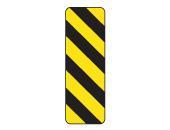
Divided highway begins: traffic travels in both directions on separated roads ahead. Keep to the right-hand road. Each road carries one-way traffic.

Right lane ends ahead. If you are in the right-hand lane, you must merge safely with traffic in the lane to the left.

Traffic lights ahead. Slow down.

Steep hill ahead. You may need to use a lower gear.

Two roads going in the same direction are about to join into one. Drivers on both roads are equally responsible for seeing that traffic merges smoothly and safely.

Snowmobiles cross this road.

Divided highway ends: traffic travels in both directions on the same road ahead. Keep to the right-hand road.

Underpass ahead. Take care if you are driving a tall vehicle. Sign shows how much room you have.

Bump or uneven pavement on the road ahead. Slow down and keep control of your vehicle.

Railway crossing ahead. Be alert for trains. This sign also shows the angle at which the railway tracks cross the road.

Sharp turn or bend in the road in the direction of the arrow. The checkerboard border warns of danger. Slow down; be careful.

Deer regularly cross this road; be alert for animals.

Truck entrance on the right side of the road ahead. If the sign shows the truck on the left, the entrance is on the left side of the road.

Shows maximum safe speed on ramp.

Watch for pedestrians and be prepared to share the road with them.

Watch for fallen rock and be prepared to avoid a collision.

There may be water flowing over the road.

This sign warns you that you are coming to a hidden school bus stop. Slow down, drive with extra caution, watch for children and for a school bus with flashing red lights.

Indicates an upcoming bus entrance on the right and vehicles should be prepared to yield to buses entering the roadway.

Indicates an upcoming fire truck entrance on the right and vehicles should be prepared to yield to fire trucks entering the roadway.

These signs warn of a school crossing. Watch for children and follow the directions of the crossing guard or school safety patroller.
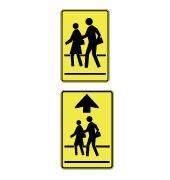
Informational Signs: Typically on yellow boards, these signs offer guidance and directions, such as route markers, distance indicators, and facility locations (e.g., rest areas or gas stations). They often use clear maps or arrows to guide drivers.Here are some common information and direction signs:
Shows directions to nearby towns and cities.

Shows the distances in kilometres to towns and cities on the road.

Various exit signs are used on freeways. In urban areas, many exit ramps have more than one lane. Overhead and ground-mounted signs help drivers choose the correct lane to exit or stay on the freeway.

Advance signs use arrows to show which lanes lead off the freeway. Signs are also posted at the exit.

Sometimes one or more lanes may lead off the freeway. The arrows matching the exit lanes are shown on the advance sign in a yellow box with the word ‘exit' under them.

Freeway interchanges or exits have numbers that correspond to the distance from the beginning of the freeway. For example, interchange number 204 on Highway 401 is 204 kilometres from Windsor, where the freeway begins. Distances can be calculated by subtracting one interchange number from another.

The term 'VIA' is used to describe the roads that must be followed to reach a destination.

Shows the upcoming roundabout exits and where they will take you.

These signs change according to traffic conditions to give drivers current information on delays and lane closures ahead.

Shows off-road facilities such as hospitals, airports, universities or carpool lots.
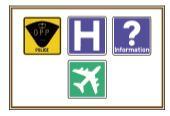
Shows route to passenger railway station.

Shows route to airport.

Temporary condition signs: Temporary conditions signs indicate road work zones, diversions, detours, lane closures or traffic control people on the road. They are usually diamond-shaped with an orange background and black letters or symbols.Here are some common temporary condition signs:
Construction work one kilometre ahead.

Road work ahead.

Survey crew working on the road ahead.

Traffic control person ahead. Drive slowly and watch for instructions.

You are entering a construction zone. Drive with extra caution and be prepared for a lower speed limit.
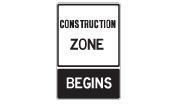
Temporary detour from normal traffic route.

Flashing lights on the arrows show the direction to follow.

Pavement has been milled or grooved. Your vehicle's stopping ability may be affected so obey the speed limit and drive with extra caution. Motorcyclists may experience reduced traction on these surfaces.

Lane ahead is closed for road work. Obey the speed limit and merge with traffic in the open lane.

Closed lane. Adjust speed to merge with traffic in the lane indicated by the arrow.

Reduce speed and be prepared to stop.

Follow the detour marker until you return to the regular route.

Enforces doubling the HTA fines for speeding in a designated construction zone when there are workers present.

Other signs
The “slow-moving vehicle” sign is an orange triangle with a red border. It alerts other drivers that the vehicle ahead will be travelling at 40 km/h or less. When on a road, tractors, farm machinery, and vehicles not capable of sustaining speeds over 40 km/h must display the slow moving vehicle sign. Watch out for these slow moving vehicles and reduce your speed as necessary.

EDR signs are used during the unscheduled closure of a provincial highway when OPP detour all traffic off the highway. The EDR markers are located along alternative routes and provide direction to motorists around the closure and back onto the highway.

2. Key Canadian Traffic Rules
In addition to understanding the signs, learner/beginner drivers must learn the traffic rules that govern the roadways:
● Right-of-Way: Knowing who goes first at intersections and pedestrian crossings is crucial. For example, at a four-way stop, the first vehicle to stop is the first to go.
● Speed Limits: Speed limits vary by area (residential, urban, rural, highway) and weather conditions. Always adjust your speed to the posted speed limits.
● Lane Usage: Proper lane discipline, including the correct use of turning lanes and passing lanes, is vital. Make sure to signal when changing lanes and always check your mirrors and blind spots.
● Safe Following Distance: Keeping a safe distance from the vehicle ahead allows you to react in time if the traffic suddenly stops or slows down.
● Pedestrian and Cyclist Safety: Yielding to pedestrians at crosswalks and being cautious around cyclists is mandatory. These rules help protect some of the most vulnerable road users.
3. Practical Tips for Beginners
● Study and Practice: Use practice tests and mobile apps to familiarize yourself with road sign meanings and traffic laws. Repetition helps reinforce your understanding.
● Observe While Driving: Pay attention to the road, signs, and other drivers. Real-world experience combined with your study will build your confidence.
● Ask Questions: Don’t hesitate to ask your driving instructor or experienced drivers for clarification on any rules or signs you find confusing.
● Stay Updated: Traffic rules can change. Keep an eye on local news or government websites for any updates to road regulations in your province.
Conclusion
Mastering Canadian road signs and traffic regulations is key to becoming a confident and responsible driver. Understanding the meaning of different road signs, following key traffic rules, and applying safe driving habits will help ensure not only your safety but also the safety of others on the road. By staying informed, practicing regularly, and being mindful of your surroundings, you can navigate Canada’s roads with ease. Remember, responsible driving isn’t just about passing a test—it’s about making the roads safer for everyone.
🚗 Need a rental car for your drive test? Check out Elan DriveTest Rental for affordable and reliable rental vehicles! 🚗
Pass Your Road Test with Confidence
Book your road test car and instructor package with Elan. Professional vehicles, experienced instructors, and free lesson perks available.
98% pass rate with our instructor packages



